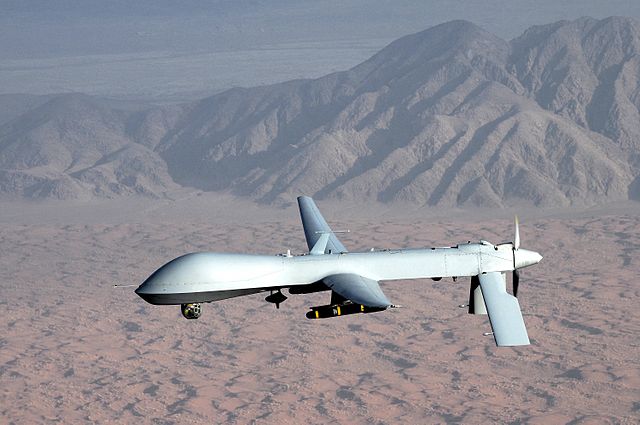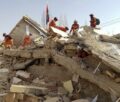US launches new drone attacks on Pakistan

By Bill Van Auken
The Obama administration ordered new drone attacks on Pakistan over the weekend, killing at least a dozen people in the tribal area of South Waziristan.
Sunday’s strike involved two drones, which fired two missiles each into a home and a car in the Wana district of the northwestern Pakistan tribal region near the Afghan border. Ten people were killed, and another ten wounded.
The attack was mounted as men came to offer condolences to the family of an alleged commander of the Maulvi Nazir group, one of what differing accounts put at between two and four men killed less than 24 hours earlier in a Saturday drone strike.
The group, led by Nazir Ahmed, is considered by the Pakistani government as “good Taliban”, because it does not seek to overthrow the regime in Islamabad and has rarely opposed the presence of the Pakistani army in South Waziristan. It has united, however, with other Pashtun groups on both sides of the border to fight the US-led occupation of Afghanistan.
The attack on a group offering condolences is in line with previous strikes that have targeted funerals for drone attack victims, as well as rescuers attempting to dig dead and wounded from the rubble left by Hellfire missile strikes.
The Pakistani press reported that the missile strikes razed the house to the ground, and that local people rushed to aid the injured and recover the remains of the dead.
News accounts of both Saturday’s and Sunday’s strikes described all of the victims as “suspected militants”. However, they follow the publication last week of a lengthy article in the New York Times detailing how President Barack Obama selects victims for assassination strikes and personally approves many of the so-called “signature strikes”—those directed not at identified “suspects,” but rather at crowds considered to be engaged in “suspicious behavior”.
The article revealed that Obama had approved a CIA policy of classifying any combat-aged male slain in a drone strike as a “militant,” in the absence of definite evidence to the contrary. This method essentially legitimizes the killing of any adult male in the border regions targeted for drone attacks.
Sunday’s strike marked the seventh drone attack since the NATO summit in Chicago last month. They have included a May 24 strike on a mosque that slaughtered 10 people as they were worshipping. A May 26 attack killed at least four people in a bakery where alleged militants were buying bread.
Already strained relations between the US and Pakistan deteriorated further at the Chicago summit after the two sides failed to reach an agreement for reopening the supply routes linking the Pakistani port of Karachi to the Afghan border. The routes were closed last November in protest over US air strikes on two Pakistani check points on the Afghan border that claimed the lives of 24 Pakistani soldiers. At the same time, the Pakistani government forced the shutdown of the clandestine Shamsi air base in Baluchistan used to support drone attacks, which had previously enjoyed Islamabad’s tacit approval.
The Pakistani supply routes were previously used to carry over 30 percent of the materiel for the US-led occupation forces in Afghanistan and are seen as crucially important for the drawdown of US-NATO forces and their equipment that is supposed to take place over the next two and a half years.
Last month, the Pakistani parliament passed a resolution making a halt to the drone strikes a precondition for reopening of the supply routes and demanding that Washington apologize for the killing of the 24 Pakistani soldiers. The Obama administration has rejected both demands.
Meanwhile, the Washington Post published an article Saturday establishing that escalating US drone strikes in Yemen are targeting individuals not because they are considered to be any “imminent threat” to the United States—the supposed criteria for selecting targets for remote-control murder—but because they are engaged in an insurrection against the US-backed regime in Sana’a.
Entitled “US drone targets in Yemen raise questions”, the Post article points to the case of Kaid and Nabil al-Dhahab, two brothers who survived after being targeted in a Memorial Day drone strike. The two were related by marriage to Anwar al-Awlaki, the New Mexico-born Islamic cleric and US citizen assassinated in a drone strike ordered by Obama last September.
Asked if the two brothers were involved in any plot against the US, a US counter-terrorism official replied: “It is still an open question.” Acknowledging that the focus of their activities are “more local”, the official defended the strike by referring to their family ties to Awlaki. “Look at their associations and what that portends.” Given the ties binding the Awlak tribe, one of the most powerful in southern Yemen, of which Awlaki was a member, this logic turns a vast population into “militant suspects” who Washington claims the right to murder with impunity.
“In some cases, US strikes appeared to be coordinated with Yemeni military advances on al-Qaeda positions in the southern provinces of Abyan and Shabwa,” the Post reports. In other words, under the pretext of combating a terrorist threat, the drone attacks are being used to help quell an uprising against the US-backed regime in Yemen.
While the drones strikes are supposedly targeted at those posing a “direct threat” to the US, an official admitted to the Post that “the elasticity of that has grown over time.” The cynical claim is now being made that those being murdered pose a threat to US Special Forces troops, CIA agents and contractors who have been sent into Yemen to organize the killings.
Out of at least 21 drone strikes conducted in Yemen since January, US authorities have been able to identify only three “high-value” terrorism suspects killed. Yemenis in the areas struck and human rights groups, however, have reported many civilian casualties from the attacks, generating growing hostility to the US and the Yemeni regime it supports.
In an article published last week, based on over 20 interviews with Yemeni tribal leaders, officials, relatives of drone attack victims and human rights workers, the Post warned that the strikes had produced “a marked radicalization of the local population.”
Courtesy WSWS.Org
-
Book Shelf
-
 Book Review
DESTINY OF A DYSFUNCTIONAL NUCLEAR STATE
Book Review
DESTINY OF A DYSFUNCTIONAL NUCLEAR STATE
- Book ReviewChina FO Presser Where is the fountainhead of jihad?
- Book ReviewNews Pak Syndrome bedevils Indo-Bangla ties
- Book Review Understanding Vedic Equality….: Book Review
- Book Review Buddhism Made Easy: Book Review
- Book ReviewNews Elegant Summary Of Krishnamurti’s teachings
- Book Review Review: Perspectives: The Timeless Way of Wisdom
- Book ReviewNews Rituals too a world of Rhythm
- Book Review Marx After Marxism
- Book Review John Updike’s Terrorist – a review
-
-
Recent Top Post
-
 NewsTop Story
What Would “Total Victory” Mean in Gaza?
NewsTop Story
What Would “Total Victory” Mean in Gaza?
-
 CommentariesTop Story
The Occupation of Territory in War
CommentariesTop Story
The Occupation of Territory in War
-
 CommentariesTop Story
Pakistan: Infighting in ruling elite intensifies following shock election result
CommentariesTop Story
Pakistan: Infighting in ruling elite intensifies following shock election result
-
 CommentariesTop Story
Proforma Polls in Pakistan Today
CommentariesTop Story
Proforma Polls in Pakistan Today
-
 CommentariesTop Story
Global South Dithering Away from BRI
CommentariesTop Story
Global South Dithering Away from BRI
-
 News
Meherabad beckons….
News
Meherabad beckons….
-
 CommentariesTop Story
Hong Kong court liquidates failed Chinese property giant
CommentariesTop Story
Hong Kong court liquidates failed Chinese property giant
-
 CommentariesTop Story
China’s stock market fall sounds alarm bells
CommentariesTop Story
China’s stock market fall sounds alarm bells
-
 Commentaries
Middle East: Opportunity for the US
Commentaries
Middle East: Opportunity for the US
-
 Commentaries
India – Maldives Relations Nosedive
Commentaries
India – Maldives Relations Nosedive
-
AdSense code




















